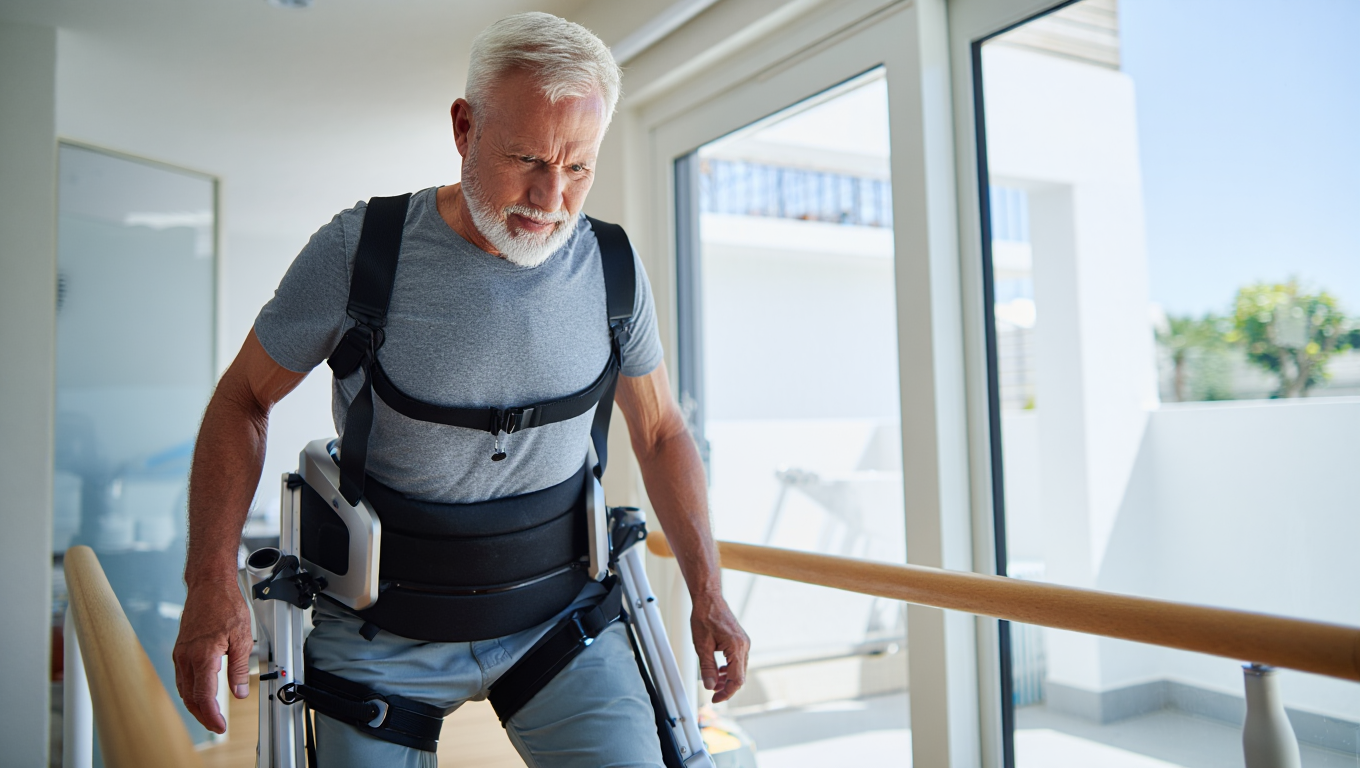Walking again after a traumatic brain injury (TBI) is one of the most emotionally and physically complex parts of recovery. For many patients, regaining the ability to walk is not only a functional milestone — it’s a symbol of independence, identity, and return to life.
Yet despite the best efforts of therapists and families, many individuals fall into long, frustrating plateaus. Why? Because while rehabilitation exercises for TBI are well known, the practical challenges in carrying them out effectively and consistently are often underestimated.
In this article, we explore the gap between what rehab should look like — and what’s really happening at home. We then introduce
Just Walk, an innovative home-based solution designed to
bridge that gap and improve outcomes.
The Reality of Gait Rehabilitation After TBI
Rebuilding gait after a traumatic brain injury requires far more than motivation. Patients face a combination of neurological, orthopedic, and psychological challenges, including:
- Balance instability — due to impaired motor control or sensory deficits
- Hemiparesis and lower limb weakness — often following damage to motor areas
- Loss of proprioception — difficulty sensing leg position or contact with the ground
- Fatigue and cognitive load — walking becomes mentally and physically exhausting
- Fear of falling — leading to avoidance and regression
These issues create a vicious cycle: the less patients walk, the more progress is lost — and the harder it becomes to restart.
Why Traditional Tools Often Fall Short
While physical and occupational therapy remain essential, traditional rehabilitation often fails to meet real-world demands, especially when it comes to gait recovery.
1. Limited therapy hours
Most patients receive outpatient rehab only 2–3 times per week. For true neuroplastic change, much more repetition is needed.
2. Unsafe or inadequate environments
Homes are rarely optimized for balance-challenged individuals. Walkers, canes, or crutches offer only partial support and can feel unstable.
3. Caregiver dependency
Patients often need another person’s assistance to walk safely, making it harder to practice regularly and independently.
4. Emotional fatigue
Frustration, fear, and a sense of helplessness can undermine rehabilitation even in patients with physical potential.
Just Walk: Removing Barriers to Gait Recovery
Just Walk is a home-based gait rehabilitation system designed to support safe, repetitive walking for patients recovering from TBI and other neurological injuries. By combining full-body support with the ability to walk in a controlled, upright posture, it enables patients to train more frequently, more independently, and with greater confidence.
How Just Walk Enhances Rehabilitation:
-
Stability and fall prevention
Removes the fear of falling — one of the biggest barriers to progress - Supports independent practice
No need to wait for a therapist or caregiver - Daily repetition encourages neuroplasticity
More steps, more often = better brain recovery - Encourages upright, functional walking
Maintains correct alignment and mimics natural gait - Boosts motivation
When walking feels safer and more successful, patients stick with it
In short: Just Walk turns therapy from a twice-weekly session into a
daily habit — one that actively rewires the brain through safe, structured movement.

The Core Issue: Patients Don't Lack Strength — They Lack Support
Many patients can take steps. But what they lack is:
- A safe way to practice
- A consistent environment
- The confidence to try
Traditional equipment and therapy alone don’t always solve this. Just Walk fills this critical gap and empowers patients to actively participate in their own recovery journey.
Frequently Asked Questions (FAQ)
What are the most effective traumatic brain injury rehabilitation exercises for walking?
Exercises that target balance, coordination, and lower limb movement are most effective. This includes weight shifting, marching in place, heel-to-toe stepping, and obstacle navigation. The key is repetition in a safe, supportive environment.
How often should gait training occur after TBI?
Ideally, daily. Consistent, high-frequency walking is essential for rebuilding brain-to-muscle communication through neuroplasticity.
Can Just Walk be used alone at home?
Yes. Just Walk is designed for safe, unsupervised use — giving patients the ability to train independently without fear of falling.
Is Just Walk better than using a walker or treadmill?
Yes. Walkers and treadmills don’t offer full-body support and often require a caregiver nearby. Just Walk provides stability, balance assistance, and upright posture control, tailored for neurological recovery.
Who is Just Walk suitable for?
It’s ideal for individuals recovering from TBI, stroke, or other neurologic injuries who have limited balance or coordination, but are ready to begin or continue
walking-based rehabilitation safely at home.
Conclusion
Traumatic brain injury rehabilitation exercises are only as effective as the system supporting them. Without stability, repetition, and confidence, even the best-designed programs can fall short.
Just Walk removes those barriers — giving patients the power to take safe steps forward, every single day. It is not just a tool for walking. It’s a bridge to freedom, function, and long-term neurological recovery.
Sources
- Dobkin, B. H. (2005). Clinical practice. Rehabilitation after stroke. New England Journal of Medicine, 352(16), 1677–1684.
- Langhorne, P., Coupar, F., & Pollock, A. (2009). Motor recovery after stroke: a systematic review. The Lancet Neurology, 8(8), 741–754.
- Kleim, J. A., & Jones, T. A. (2008). Principles of experience-dependent neural plasticity: implications for rehabilitation after brain damage. Journal of Speech, Language, and Hearing Research, 51(1), S225–S239.
- Teasell, R., et al. (2014). Evidence-Based Review of Stroke Rehabilitation: Executive Summary, 12th Edition. EBRSR.
- Winstein, C. J., et al. (2016). Guidelines for adult stroke rehabilitation and recovery: A guideline for healthcare professionals from the American Heart Association/American Stroke Association. Stroke, 47(6), e98–e169.
- Schmid, A. A., Van Puymbroeck, M., & Koceja, D. M. (2013). Fear of falling in people with stroke: the role of balance, strength, and gait. Physical & Occupational Therapy in Geriatrics, 31(3), 214–224.
Important
This article is for informational purposes only and is not a substitute for professional medical advice; always consult your doctor or physical therapist before starting any exercise or using any device.



